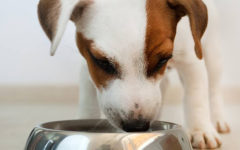PFI’s Pat Tovey, senior director of food safety and regulatory compliance, discusses the many steps pet food producers take to ensure ingredient safety throughout the pet food manufacturing process.

As makers of sole source nutrition for pets in America and around the world, Pet Food Institute (PFI) members take seriously their commitment to producing safe pet food. This means companies follow careful testing and monitoring procedures, from incoming ingredients to throughout the manufacturing process. Pet food is one of the most regulated food products in the United States, with pet food makers already including a risk assessment approach under the Food Safety Modernization Act (FSMA), in addition to internal food safety plans to further support making safe food for dogs and cats.
Within these steps, pet food makers identify possible hazards in the food manufacturing practice and implement controls, called “preventive controls,” to help mitigate those possible incidents. For example, this could include using heat treatment – cooking to a certain temperature – to control for salmonella. Within a pet food maker’s food safety plan, they must identify hazards and then also identify and implement programs to control them.
Trusted Ingredient Suppliers
If a pet food maker manages a preventive control through their ingredient supplier, that company is required under FSMA to conduct regular audits and routine reviews of that supplier. This allows for pet food makers to confirm that their ingredient supplier is performing the appropriate safety steps.
Pet food makers can proactively take other steps as part of the supplier/manufacturer relationship to ensure ingredient safety and quality, such as:
- Conducting regular audits, even when not required under regulation.
- Setting ingredient specifications, often related to factors, such as nutritional content or physical quality standards, such as color or shape.
- Requiring that the ingredient supplier provide a Certificate of Analysis (CoA) that confirms quality and safety checks.
The bottom line: it’s important for pet food makers to know their suppliers and be intimately familiar with their processes.
Ingredient Safety Checks
In addition to close relationships and audits of ingredient suppliers, pet food makers take additional safety steps at the manufacturing facility. Some common processes for different types of ingredients include:
Grains: While grains such as corn, wheat or rice can provide important nutrition for our pets, it is important for pet food makers to ensure these ingredients are safe. PFI members recognize the possibility of mycotoxins in grains, which may occur during extreme weather growing seasons, such as unusually dry or wet conditions.
For example, pet food makers will sample and test incoming loads of grain ingredients upon arrival at the manufacturing facility. Prior to receipt, the pet food maker can pull a representative sample from throughout the load for testing to make sure the product is safe, and not allow entry into the facility if the ingredient does not meet safety standards. A step such as this would meet the preventive control requirements of FSMA, since the company is taking steps to mitigate that identified hazard.
Meals and Other Animal Products: Our pets love the taste of animal-derived ingredients, such as meals, fats or by-products, and they help provide the critical nutrition dogs and cats need. However, just as with human food, animal ingredients carry a risk of containing pathogens such as salmonella, E. coli or listeria. To address this known hazard, pet food makers take ingredient safety steps such as cooking at a high enough temperature to remove those pathogens, following effective environmental cleaning and sanitation procedures, or using other emerging technologies to control pathogens like irradiation or high pressure processing.Finally, pet food makers take seriously the possible presence of pathogens throughout the production line. Facilities may take random samplings of the production environment to ensure no salmonella or other pathogens are found and that the environment is not conducive to the growth of these bacteria.
Keeping Food Free of Physical Hazards: Did you know pet food makers may even go so far as to use magnets, metal detectors or density detectors to keep food safe? As ingredients move between trains, trucks, production lines and packaging, it is possible that items, such as small rocks or pieces of metal can somehow enter the product. Pet food makers are aware of this risk and work to keep food safe along the way by monitoring for any outside objects that don’t belong.
Furthering a Commitment to Food Safety
The takeaway: PFI members use food safety plans and trusted suppliers to keep your pet and their food safe, and implement a variety of proven practices and the latest food safety science. PFI members are also committed to continuous improvement in food safety and work internally to share learnings and fund new research – all to support long and healthy lives for pets. From even before the ingredient reaches the pet food facility – all the way through the manufacturing process – and as food goes into the bag, pet food makers utilize science-based processes to ensure safe food for your dog and cat.



